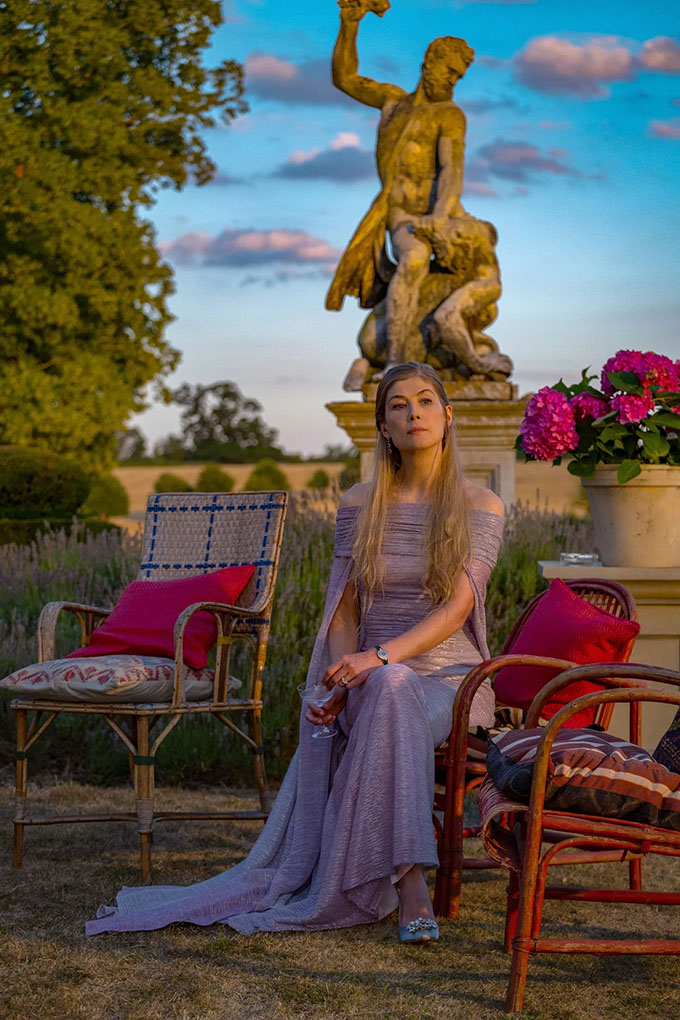Oliver Quick (Barry Keoghan) is an outsider from the moment he walks into Oxford, and everyone can tell just by taking one look at his outfit. Saltburn, the new dark comedy meets psychological thriller from Emerald Fennell, dives into the gaping chasm of class in early-aughts Britain, exploring the lengths people will go to close the gap and what it means to belong. Jacob Elordi stars alongside Keoghan as Felix Catton, an effortlessly cool—and posh—classmate who invites Oliver home to his family’s estate, Saltburn, for the summer.
Clothing is an enormously important indicator of belonging in the film, writer-director Fennell tells Vogue. “The thing that is apparent in this movie—and that is very true of the British class system—is the less you dress up, the richer you are.”
Fennell tapped Bridgerton season-two costume designer Sophie Canale to build out the aughts wardrobes of the young aristocrats and the interloper in their midst. Canale’s experience working on the Regency-era show came in handy. “This film is only set 15 years ago, but we had to treat it like period drama,” Fennell says. Canale seconds this, even “as much as people [say] it’s a contemporary piece.” She luckily had firsthand experience with this particular period, though, lending her some credibility as a costumer. “Emerald and I had a meeting, and I produced mood boards with lots of images of my friends and I very drunk at uni on Facebook,” Canale says.


With ’90s fashion all the rage, Fennell made a conscious decision to move Saltburn closer to present day, beginning the film in the fall of 2006. “The reason that I chose that time period is that it’s not back in fashion yet but it’s not so old that it’s vintage,” Fennell says. “But it doesn’t look good anymore.”
Yet choosing to set the film in the recent past led to some difficulties for Canale. “The difficulty was actually finding this stuff because it’s still in people’s wardrobes for the most part—it’s not yet hit the consignment stores,” Fennell says. “A lot of the time Sophie was rummaging through people’s cupboards to find the clunky shoe boot, the little shrug, the thin scarf that needed to be wound multiple times around the neck and over 38 necklaces.”
When sourcing the more accessible high-street styles, Canale had to go an unorthodox route. Because the clothes she needed weren’t in costume houses or charity shops, she went straight to the source. “I was shopping on eBay, Depop, I was buying it from people’s wardrobes,” she says. But finding cringe-inducing 2000s pieces left Fennell’s ego inadvertently bruised. “It was really devastating because often the costume [team] would come and say, ‘Oh, my God, we’ve found literally the most embarrassing T-shirt you’ve ever seen. It’s horrific,’” she says. “And I would [think], I have that T-shirt, I still wear that T-shirt, and then go home and throw it away.”
Fennell also lent some of her own clothing to the film, including an Alexander McQueen jacket she bought on eBay for £150 that Rosamund Pike’s character, Elspeth, wears. (“Rosamund wore it, and then it ruined the jacket for me because she looked so amazing,” she jokes.) When it came to the rest of the designer goods, Canale worked directly with several fashion houses—including Chanel, Valentino, Dior, Chloé, Christopher Kane, Agent Provocateur, and Jenny Packham—to costume Saltburn’s eccentric residents and visitors.

As is the nature of vintage, some costumes had a rich history. For Venetia, the troubled youngest Catton (played by Alison Oliver), Canale looked to contemporary references like Keira Knightley, Sienna Miller, and Kate Moss, while still maintaining an edge and a wayward sense of self. “We had pieces that Amy Winehouse wore for Venetia,” Canale says.
The costume designer pulled from similar pop-culture references for the Oxford girls. “Kate Moss did a Topshop collection around that period, so Annabelle and some of the girls from the university we wanted to have those Kate Topshop dresses,” Canale says. For Pike, though, Canale sought to reflect Elspeth’s past as a free-spirited model and how that played into her elite social standing. “I wanted her to have these fashions, but I also wanted her to be bohemian, relaxed, so it wasn’t this stuffy English upper-class [style].”
It wasn’t only the girls who adopted fashions of yore. Alongside his wardrobe filled with Ralph Lauren shirts with popped collars, Elordi’s Felix sports an eyebrow piercing at Oxford, something Fennell had to fight the producers for. “I knew in my soul, having been a young woman in 2007 myself, that an eyebrow piercing would be the thing that would make you entirely lose your mind,” she says. “‘We don’t understand why you would mar the most beautiful man in the world’s face with an eyebrow piercing,’” Fennell recalls producers telling her. “If you have never been round the back of a nightclub with a boy with an eyebrow piercing and then cried into your kebab later, you have no skin in this game,” she replied.
But perhaps nobody reflects their station better than Oliver, who is immediately singled out for his try-hard jacket and clocked for his rental tuxedo. “Everything that Oliver has is a cheaper version of what it’s meant to be, and everything Felix is wearing is a label, and the materials are better,” she says. “I wanted Felix to be so casual and comfortable in his clothes, whereas Oliver is so uptight.” While Canale worked to give Felix’s designer clothing a worn-in feeling, she left Oliver’s with a starchy newness. “Everything’s box fresh,” she says. “I wanted everything to look new because that’s what he’s done—he’s gone to the shop, he’s packed his new wardrobe. Everything has a newness to it. I wanted to give the essence that he’s still slightly uncomfortable in those clothes.”
This article was originally published on Vogue.com.





